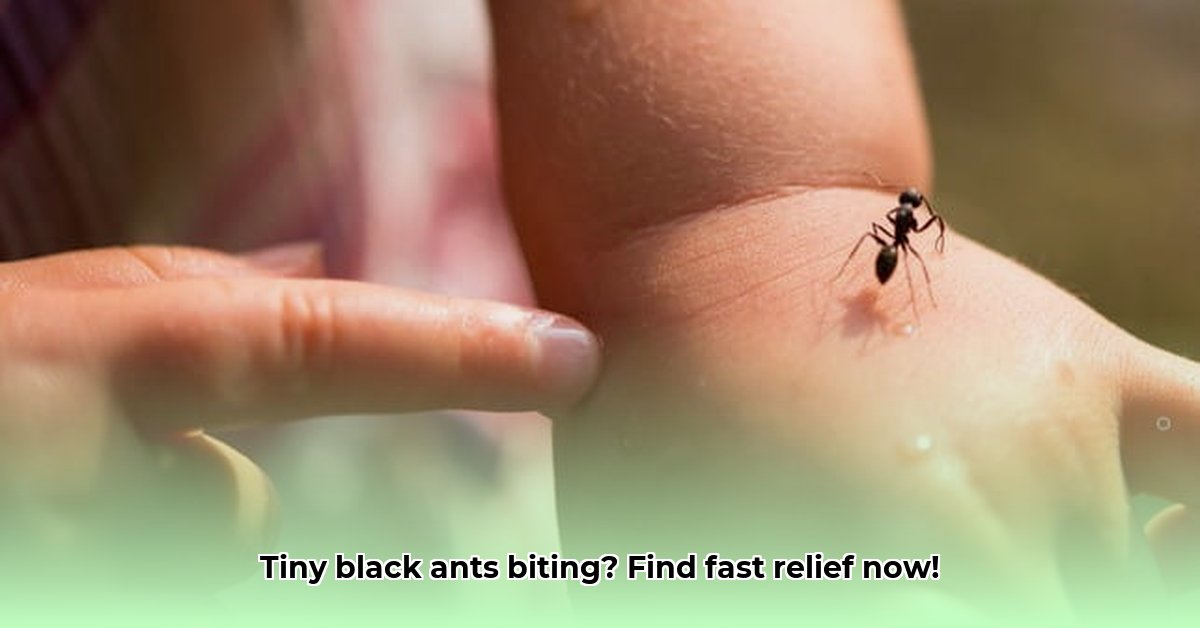Have tiny black ants invaded your kitchen, leaving you wondering if they bite? The answer is, yes, some do! Though usually not serious, their bites can be itchy and irritating. This instructional guide helps you identify biting ants, treat the bites, and prevent future infestations. We’ll cover everything from home remedies to when you need a professional. Let’s reclaim your home! For more information on identifying different ant types, check out this helpful guide on carpenter ants vs. black ants.
Do Tiny Black Ants Bite? Finding Relief and Prevention
So, you’ve spotted tiny black ants and are asking, “Do these little guys bite?” Yes, they can. While their bites are generally not dangerous, they can be irritating, leading to inflammation and discomfort. This section helps you identify these invaders, soothe the bites, and prevent return visits.
Identifying the Tiny Troublemakers: Species and Characteristics
Identifying the exact ant species can be tricky, but is essential for targeted eradication. Common culprits behind these bites are often Pharaoh ants (Monomorium pharaonis) or little black ants (Monomorium minimum). Knowing the species helps you choose the best eradication approach. Distinguishing their features refines your attack plan.
Telling different ant species apart is like identifying subtle variations in sparrows. Observe their size (some are very tiny, ranging from 1.5mm to 3mm!), their shades of black (some may have a reddish tinge), and their organization (do they have well-defined trails?). University entomology websites have helpful pictures, detailed descriptions, and distribution maps. Accurate identification contributes to effective prevention. Key identifiers include:
- Size: Pharaoh ants are typically 1.5-2mm long, while little black ants are 1.5-3mm.
- Color: Pharaoh ants are yellowish-brown, whereas little black ants are dark black.
- Nest Location: Pharaoh ants nest in warm, hidden areas, while little black ants often nest outdoors.
- Behavior: Pharaoh ants are attracted to sweets and grease; little black ants consume varied foods.
Treating Those Itchy Bites: Relief and Remedies
Generally, a tiny black ant bite is a minor inconvenience: redness, swelling, and persistent itching. However, for some, these bites can trigger an allergic reaction. Knowing how to treat the bite effectively is important.
Step-by-Step Bite Relief:
- Cleanse the Wound: Gently wash the bite with mild soap and water to prevent infection. Use an antibacterial soap for optimal hygiene.
- Cool It Down: Apply a cold compress (ice pack wrapped in cloth) for 10-15 minutes to reduce swelling and numb the itch. A cold compress can mitigate inflammation.
- Over-the-Counter Help: Hydrocortisone cream reduces inflammation and itching. Calamine lotion can also soothe irritated skin. Oral antihistamines can help, especially if you’re feeling particularly itchy. Antihistamines counteract allergic reactions.
- Elevate the Affected Area: Elevating the bitten area can help reduce swelling and discomfort.
When to Call the Doctor:
If you notice difficulty breathing, widespread swelling, a spreading rash, dizziness, nausea, or chest tightness, seek medical attention immediately. These are symptoms of a severe allergic reaction requiring professional medical help. Prompt medical attention is crucial.
Nature’s Helpers (With a Grain of Salt):
Diluted tea tree oil or peppermint oil may soothe itchy bites for some. Lavender oil and aloe vera gel are also known for their soothing properties. Don’t rely on these alone, especially if the bite causes significant discomfort. Always perform a patch test before applying essential oils to a larger area, as some individuals may experience skin irritation. Be cautious if relying solely on natural remedies.
Waging War on Ants: Treatment Options and Strategies
Several methods exist to tackle infestations, each with pros and cons. Knowing what solutions tackle what issues are imperative.
| Method | Pros | Cons |
|---|---|---|
| Bait Stations | Effective long-term control; less messy than sprays. Attracts ants with slow-acting poison and is carried back to the colony. | Takes time to work. Ants need to carry the bait back to the colony, for eradication. Can be ineffective if the wrong bait is used. |
| Sprays | Provides quicker relief; effective at killing ants on contact. Can create a barrier to prevent further entry. | Often needs repeated applications, can be messy, and might not target the entire colony. May contain harsh chemicals. |
| Insecticide Dust | Effective in hard-to-reach areas behind walls and under appliances. | Can be messy if over-applied. Requires careful application to avoid inhalation; should not be used where children or pets can access it. |
| Professional Pest Control | Thorough and effective for large infestations, expertise in species ID. Uses specialized equipment and treatments not available to the general public. | More expensive, might involve stronger chemicals. Requires scheduling an appointment and may require preparations before treatment. Consider it a one-time investment for resolution. |
| Natural Repellents | Non-toxic options safe for use around children and pets. Includes vinegar, lemon juice, cinnamon, and peppermint oil. | Generally less effective than chemical treatments and require frequent reapplication. May only repel ants rather than eliminate the colony. |
| Diatomaceous Earth (DE) | Non-toxic to humans and pets. Works by dehydrating insects. | Only effective when dry. Can be messy and may require multiple applications. |
Choosing Your Weapon:
Bait stations are ideal for a long-term ant-management strategy, because ants take the poisoned bait back to the nest, eliminating the colony. Sprays offer faster results but need multiple applications. Insecticide dusts are great for treating hard-to-reach areas. If you have a massive infestation or recurring problems, calling a pest control professional is most effective. Pest control professionals can rid your home for good.
Preventing Future Ant Encounters: A Proactive Approach to Pest Control
The best way to deal with ants is to prevent them from invading. Around 75% of pest problems are preventable.
- Cleanliness is Next to Ant-lessness: Wipe up spills immediately, especially sugary drinks. Ants are drawn to these quickly. Clean under appliances regularly as well.
- Food Storage: The Airtight Approach: Store all food items, including pet food, in sealed containers to prevent those scavengers from finding a buffet. Proper storage is crucial. Consider using glass or sturdy plastic containers with tight-fitting lids.
- Seal the Cracks: Inspect your home for cracks in walls, windows, and around pipes. Seal them with caulk to block ant highways into your home. Pay special attention to areas where pipes enter the house. Sealing crevices prevents unwanted entry
- Regular Cleaning: Regular sweeping, vacuuming, and mopping reduces the chance of food scraps attracting ants. Pay close attention to corners and edges where crumbs tend to accumulate. Keep crumbs at bay.
- Landscaping: Trim shrubs and trees away from the house to prevent ants from using them as bridges to enter. Keep mulch away from the foundation as it can provide a nesting site for ants.
- Manage Moisture: Repair leaky faucets and pipes to eliminate water sources that attract ants. Ensure proper drainage around the foundation of your house.
The Winning Strategy: A Multi-Pronged Attack for a Pest-Free Home
Managing ants effectively is usually about combining methods. Tackling an ant issue requires effective treatment of bites and a commitment to prevention. A clean home, sealed openings, and strategic use of ant-control methods creates a proactive approach to keep these invaders out. Prevention and strategic attacks lead toward victory.
How to Identify and Treat Different Types of Tiny Black Ants Pest Control
Key Takeaways:
- Tiny black ants, often odorous house ants (Tapinoma sessile), Pharaoh ants (Monomorium pharaonis) or little black ants (Monomorium minimum), are common household pests. Eliminating them is a crucial task.
- Identifying the specific ant species is crucial for effective treatment since different species are vulnerable to different countermeasures.
- Multiple approaches—cleaning, sealing entry points, and using appropriate treatments—are necessary for effective control.
- Professional help is recommended for severe infestations or allergic reactions. When the infestation is too much, it is time to call a professional.
- Prevention is crucial for long-term control and peace of mind. It doesn’t hurt to plan ahead!
Identifying Your Tiny Black Ant Invaders Pest Control
First things first: precise identification is key because several species cause similar problems. For instance, the infamous odorous house ant (Tapinoma sessile) is widespread in North America. Their odor, a rotten coconut scent when crushed, helps to identify them. Pharaoh ants (Monomorium pharaonis) are another common culprit, known for their small size and yellowish-brown color. Little black ants (Monomorium minimum) are also prevalent, characterized by their dark black color and small size. Identifying will set the stage for eliminating them.
Other tiny black ants exist with similar appearances but different habits. Pavement ants (Tetramorium caespitum) are another
- Gluten Free Meal Prep Ideas for Delicious, Hassle-Free Eating - November 28, 2025
- Gluten Free Meal Prep for Stress-Free and Healthy Eating - November 27, 2025
- Quick And Easy Chicken Thigh Meal Prep For Weight Loss - November 26, 2025










